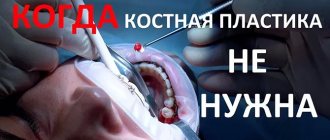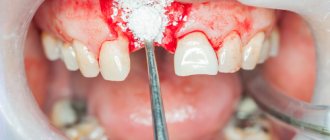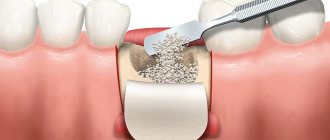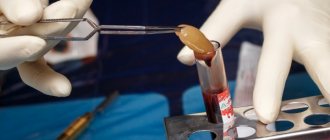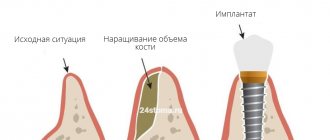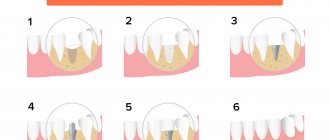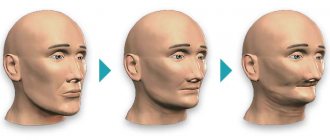NBR is one of the methods of bone augmentation before implantation. Surgery is used to guarantee the primary stability of the implant and eliminate the risk of rejection of the titanium root and the development of tissue inflammation. The lack of bone is filled with a bone substitute, which is secured with a membrane. They use their own or synthetic materials. The method is safe: surgery is performed under local anesthesia, small tissue incisions are made, bone material is grafted, and the process of graft engraftment is monitored.
What is Guided Bone Regeneration
Guided bone regeneration is an operation to compensate for the lack of bone tissue with a substitute, which is secured with a barrier membrane. After the procedure, a framework is formed around the transplant (it is formed by vessels and osteocyte cells that produce new tissue). Natural bone is gradually replacing artificial material.
Extensions using the NDT method are carried out according to classical parameters:
- thickness of the vestibular bone wall (at the cheek) - up to 2-2.5 mm;
- bone thickness between the implant and the root of the adjacent unit - up to 2.5-3 mm;
- The thickness of the bone wall between two titanium roots is up to 3 mm.
Indications
The operation allows you to increase the “necessary” volume for high-quality classical implantation, helps restore the functions of the jaw, and returns the gums to an attractive appearance.
The bone is built up “with reserve”, since after the operation the surface layers will be supplied with a small amount of oxygen due to their lower blood circulation. Therefore, the volume of inevitable tissue resorption is calculated.
In addition to implantation, indications for NRC are:
- rapid restoration of physiological parameters after tooth extraction;
- congenital or acquired defects of the bone around the teeth;
- prevention of tooth displacement, loosening, and loss due to periodontal tissue diseases.
Why does atrophy occur?
Examples of work “Before” and “After”
Restoration of all teeth on the upper and lower jaw - basal implantation
Case: partial absence of teeth on the upper and lower jaw, complicated by severe periodontitis (tooth mobility).
Complex one-stage implantation of the lower jaw
Case: there was a loose bridge of 4 front teeth on the lower jaw; after diagnosis, removal of the remaining teeth and coplex basal implantation were prescribed.
Restoration of all teeth using basal implantation method (March 2012)
Case: partial adentia, exposed roots of natural teeth, periodontitis, increased tooth mobility, severe atrophy of bone tissue in some places beyond the possible norms for classical dental implantation.
Restoration of anterior teeth using basal implantation method (April 2012)
Case: partial absence of front teeth and destruction of supporting teeth under the prosthesis, the relief of the gums and interdental papillae is disturbed.
What bone materials are used
Osteoplasty involves the use of bone replacement materials. Previously, transplants were used that were not widely used due to frequent rejection of foreign material:
- Allografts
are donated bone from other people. The material was obtained from corpses, processed, sterilized, and stored in bone tissue banks. - Xenografts
are animal bones (cattle, pigs). The material was freed from proteins by heating (to eliminate the possibility of an allergic reaction after transplantation).
We do not use outdated techniques. Nowadays, many synthetic components have been developed that promote the growth of our own bone, which we use to build bone tissue.
Synthetic materials have a high degree of affinity and compatibility with natural bone and are its analogues. These are granular formulations based on:
- calcium phosphates;
- chondroitin sulfate;
- bioglass.
The effectiveness and safety of artificial materials has been confirmed by numerous studies. They are easy to use, take root well, promote the regeneration of your own bone, and are hypoallergenic.
With osteoplasty, a combination of an artificial substitute and a person’s own bone in the form of chips (autograft) is possible. The technique helps preserve the volume of built-up bone tissue and speed up the rate of recovery. The same method helps if you have to grow a large amount of tissue.
If there is a slight shortage, you can only get by with synthetic materials.
Bone grafting at NovaDent clinics
For treatment and restoration of teeth, you are invited by the NovaDent network of dental clinics in Moscow and the region. Medical services here are provided by experienced specialists of the highest category. Modern equipment of clinics, the use of innovative technologies and advanced treatment methods allow them to carry out bone tissue augmentation during implantation with high quality and with minimal discomfort for the patient, minimizing the risk of negative consequences after surgery. Bone grafting in the lower jaw can be performed simultaneously with implantation. This is more comfortable for the patient. But if there is a clear lack of bone tissue, then a separate operation is performed.
Bone material for implantation can be obtained from donor bone from a patient (autogenous) or another person (allogeneic), synthetic (alloplastic) or animal origin (xenogeneic). The price of dental bone tissue directly depends on the type of material used.
The price for bone tissue augmentation in the lower jaw depends on the chosen technology, the material used, the degree of atrophy and is negotiated in each specific case only after a detailed examination by a doctor.
Our website contains the addresses of 15 NovaDent clinics in Moscow and the Moscow region, and a price list indicating the price of bone grafting of the lower jaw and other services for the treatment and restoration of teeth provided in our clinics. Promotions and special offers for payment for services are periodically held, and installment payments are provided. Clinics are open daily. Make an appointment by calling the phone number listed on the website. Contact the nearest NovaDent clinic at a time convenient for you!
Expert of the article you are reading: Griboyedov Pavel Olegovich Implantologist, Orthopedic Dentist, leading specialist of the NovaDent network
15 years
Clinical experience
Skhodnenskaya
Khimki Boulevard, 14, bldg. 2
+7
Free consultation with this specialist
Types of membranes
The membrane technique used by the surgeon is needed to isolate the space from fibrous tissue - creating conditions for normal tissue regeneration. There are several requirements for membranes:
- biological compatibility;
- strength;
- prevention of migration of epithelial cells;
- corresponding resorption period.
In practice, two types of membranes are used:
- Resorbable.
They dissolve on their own 6-24 weeks after extension. Membranes are used for small defects (when you need to build up no more than 2 mm) - they do not hold their shape as well as the next type. - Non-resorbable.
They do not dissolve - they are eliminated several months after surgery.
To quickly fuse the artificial material with the jaw bone tissue, in some cases membranes from the patient’s blood plasma are used.
Why does bone deficiency occur?
There are many reasons that lead to bone thinning and reduction in size. Let's analyze each of them:
- tooth extraction (regardless of the reasons for extraction) ensures that physical activity on the area where the root was previously stops. As a result, the tissue atrophies and gradually dissolves;
- congenital jaw defect or occlusion pathology;
- injury;
- age-related changes in old age;
- inflammatory process in the oral cavity affecting the jaw.
NDT stages
The operation is performed under anesthesia. The surgeon acts according to the classical algorithm:
- He cuts the gum along the hole of the lost tooth, makes several cuts on the side - peels off the gum flap.
- Fixes the implant into the exposed bone (if the operation is organized simultaneously with implantation).
- Replaces the missing volume with a graft, covers it with a membrane with a protrusion of 2-3 mm beyond the bone material. If it does not exclude the fact that the membrane is being pressed into the defect, a titanium mesh is placed on top.
- Secures the membrane (with sutures or screws).
- Brings the edges of the wound together and applies stitches.
The operation lasts 1-1.5 hours.
Algorithm for performing osteoplasty
Bone grafting consists of several stages, including preparation, surgery, rehabilitation, and osteosynthesis. Osteoplasty algorithm:
- preparation begins with a comprehensive examination of the patient. During this stage, the doctor collects anamnesis, identifies indications and contraindications, and visual and hardware diagnostics. All this allows the surgeon to make a diagnosis, determine the degree of atrophy and the characteristics of the clinical case. Based on the conclusions made, the doctor plans the type and course of surgical treatment;
- Sanitation of the oral cavity is a prerequisite for the operation. This complex includes dental and periodontal treatment (if necessary), professional dental cleaning;
- surgical stage – performed according to a developed protocol depending on the type of plastic surgery. General scheme: local anesthesia, gum incision to gain access to the operated area, preparation of a bed for laying the graft, fixation of bone material and growth stimulator, suturing of the surgical wound;
- the process of osteosynthesis (formation of new bone tissue). Lasts up to 6 months. The duration depends on the type of plastic surgery and the transplant materials used.
General recommendations for the rehabilitation period:
- do not eat or drink for 3 hours after surgery;
- do not brush the surgical area with a toothbrush for at least 10 days;
- food should not be hot or cold, it should be finely chopped during the entire time until the surgical suture heals;
- Do not drink through a straw or blow your nose (especially after a sinus lift);
- you should refrain from physical activity (including fitness) for at least 2 weeks after surgery;
- be sure to take medications prescribed by the doctor;
- it is necessary to monitor your well-being and the site of surgery. If inflammation, swelling, or temperature occur, immediately consult your doctor.
Expert advice: 2 hours before surgery you should refrain from eating. After surgery, it is necessary to meticulously adhere to the surgeon’s recommendations on nutrition, hygiene, and physical activity. stress, as well as taking prescribed antibiotics and other medications. Otherwise, postoperative complications are possible.
The dental network offers osteoplasty services. Our surgeons are highly qualified and improve their skills in famous clinics in Russia and Europe. The quality of surgical operations meets international standards. We have a system of family and cumulative discounts. We provide the necessary documents for filing a tax deduction. Convenient appointment schedule with specialists: daily without a break from 9 to 21 hours (Sunday from 10 to 16).
Branches of our orthodontic center are located in Moscow within walking distance from the metro:
- Art. Alekseevskaya (VDNKh district, etc. Mira), address: st. 3rd Mytishchiskaya house 3, building 2;
- Art. Shelepikha, address: Shelepikhinskaya embankment, address: building 34, building 1.
You can trust us with your health, come, we will solve any dental problem. Waiting for you!
Can it be done simultaneously with implantation?
Two operations are combined into one if the following conditions are met:
- the shape of the defect allows you to correctly install the artificial root in any of the planes;
- when installed, the implant is located within the bone contour (does not go beyond the tangent drawn to the bone line);
- eliminate a horizontal (not vertical) defect.
The implanted implant can become a barrier to the growth of blood vessels and inhibit the formation of new bone. If the implant protrudes beyond the contour of the bone tissue, the risk of developing fibrous tissue with inclusions of the implanted material cannot be ruled out.
Materials used
Installing an implant allows you to restore the root system, but this requires a sufficiently dense base that can fix the artificial pin, which necessitates the use of osteoinductive agents that stimulate regeneration. Double-layer collagen membranes treated with a restorative drug allow you to restore the natural blood circulation cycle. The material used for the manufacture of membranes includes resorbable and non-resorbable elements that differ in functional properties. During directed regeneration, bioactive compounds and distracting compounds are also used - to obtain the optimal combination, doctors combine various elements that help accelerate integration.
